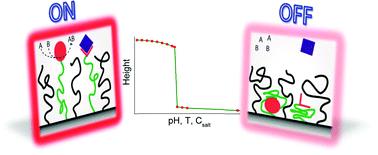 In this article, Scheutjens-Fleer self-consistent field (SF-SCF) theory simulations were used to accurately predict the position of a nanoparticle attached to the end-group of a responsive polymer chain surrounded by a majority of non-responsive polymer chains in a mixed brush system.
In this article, Scheutjens-Fleer self-consistent field (SF-SCF) theory simulations were used to accurately predict the position of a nanoparticle attached to the end-group of a responsive polymer chain surrounded by a majority of non-responsive polymer chains in a mixed brush system.
Certain stimuli such as pH or temperature can be used to create a defined ‘on-off’ switch between a protected ‘off’ state, where the responsive polymer chain is contracted thus burying the nanoparticles well within the non-responsive components, or an ‘on’ state where the nanoparticle is exposed to the medium through swelling of the responsive polymer chains.
The solvent quality was parameterised by the Flory-Huggins interaction parameter (χ) and for nearly all investigated systems there was a sharp transition at the so-called critical χ value between the on-off state. Design variables for mixed polymer brushes such as grafting density, chain length and nanoparticle size were investigated and all had an effect on the critical χ value, with a larger particle size and grafting density leading to an increase in χ. Fixing the polymer chain length for both responsive and non-responsive polymer chains led to the most optimal switching.
The authors are planning to develop materials from these findings and use the mixed polymer brush-nanoparticle systems as rapidly responsive (bio)sensors with single molecule sensitivity.
Responsive polymer brushes for controlled nanoparticle exposure
Namik Akkilic, Frans A. M. Leermakers and Wiebe M. de Vos
Nanoscale, 2015,7, 17871-17878, DOI: 10.1039/C5NR05150A
Dr Mike Barrow is a guest web writer for the Nanoscale blog, he currently works as a Postdoctoral Researcher at the University of Liverpool. Twitter: @mikesyb










